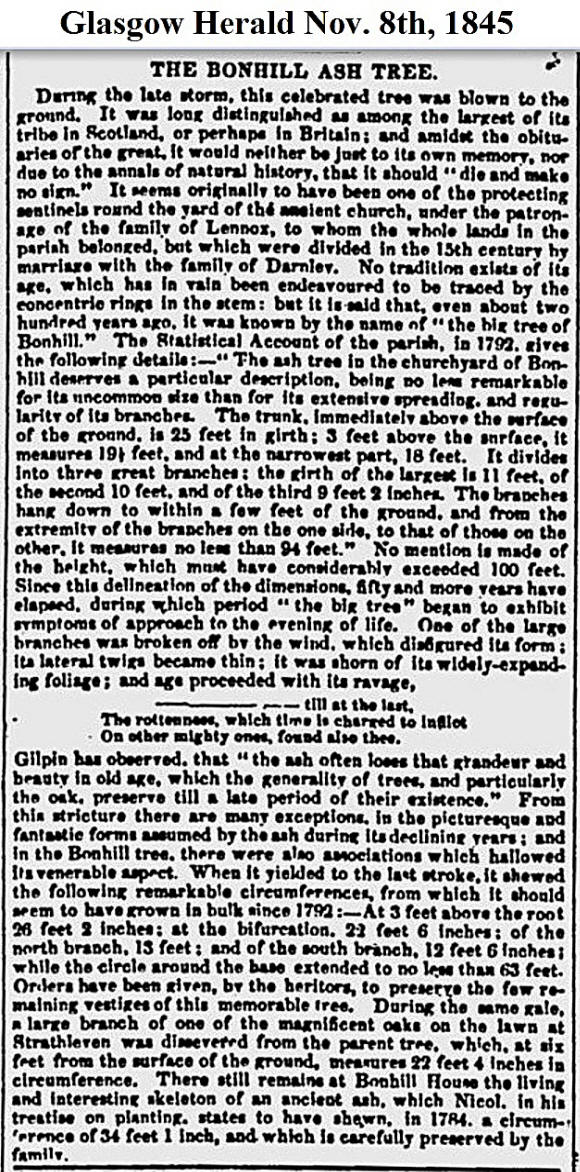|
1845,
Nov 8 The Bonhill Ash Tree

Bonhill And Its Ash
Trees .... that supplements the Glasgow Herald
report in December, 1845
A very remarkable ash grew at Bonhill,
Dunbartonshire, being a sort of " family tree" of
the Smolletts, who have been proprietors of Bonhill
for a very long period. It had been surrounded, for
its preservation, with a sloping mound of earth
about 3 feet in height. In September 1784, at the
top of this embankment it girthed 34 feet 1 inch; at
4 feet higher up, it was 21 feet 3 inches; and at 12
feet from the ground, it was 22 feet 9 inches; where
it divided into three huge arms. At this point, the
leading trunk had, about a century before, been
broken over, in consequence of which the tree had
become hollowed. One of these arms measured 10 feet
4 inches; another, 11 feet; and the third, 12 feet
in girth; and yet they seem not to have been
original branches, but only pollards formed after
the trunk was broken over. As the stump had become
quite hollow, and open on one side, we learn from Dr
Walker that the opening was formed into a door, and
the decayed heart scooped out, so that a room was
formed in it, 9 feet 1 inch in diameter, with a
conical roof 11 feet high; and was floored, and
surrounded with a hexagonal bench, on which eighteen
people could sit; and above the door, five small
leaden windows were fitted. In this condition this
remarkable trunk lived on, forming a great deal of
young wood in the shell or bark; and in 1812, Dr
Walker states that "it was thickly covered with
fresh vigorous branches, and, by this sort of
renovation, may continue to live, nobody can say how
long." After very careful inquiry, we have been so
fortunate as to ascertain that a remnant of this
remarkable tree still exists. There is remaining a
shell, about 12 feet high and 3 feet broad, of one
side of its trunk, covered with healthy bark and
young twigs. This relic is surrounded by an iron
railing for its protection. The bark is still well
covered with small branches; and about 18 inches
from the ground, a pretty large branch has sprung
up, which may, in future centuries, be a rival to
its sire. Judging from the dimensions given by Dr
Walker, this ash may fairly be allowed to divide the
honour of being the largest of its day, in Scotland,
with the Kilmalie tree.
In the parish churchyard
of Bonhill stood another venerable ash tree, which,
in September 1784, measured, at 3 feet from the
ground, 17 feet 9 inches; but at 1 foot above the
ground, it was no less than 33 feet in girth. It was
about 50 feet in height, and had a wide spreading
head. In 1768 it was measured by Mr Beevor, and
found to be 16 feet 9 inches at 5 feet above the
ground. In 1812 it was quite fresh and vigorous.
This tree perished in a gale on 1st November 1845.
Its circumference, at 3 feet from the root, was 26
feet 6 inches; and at its bifurcation, 22½ feet. Its
north branch was 13 feet, and its south limb 12½
feet in girth. The circle round the base was 63
feet; and its height considerably over 100 feet; and
the spread of its branches 100 feet in diameter. A
lithograph of the tree hangs in the session-house of
the parish church; and two chairs, made from the
wood of the tree, stand in the vestibule of the
church, and bear the following inscription:—"This
chair, with another of the same wood and pattern,
made by James Nairn, cabinetmaker in Bonhill, of
part of the great ash tree that stood for centuries
in the south-west corner of the kirkyard of the
parish of that name, and fell by a very high wind on
1st November 1845, was presented to the Established
Church in that parish by the Rev. William Gregor,
minister thereof, on the 16th January 1847." The
wood was sold to more than one joiner, and was made
into articles of furniture. The lithograph of the
tree referred to was sold in the parish, and is
still to be seen in several houses; it was mounted
in a frame made from the wood of the tree itself.
|

